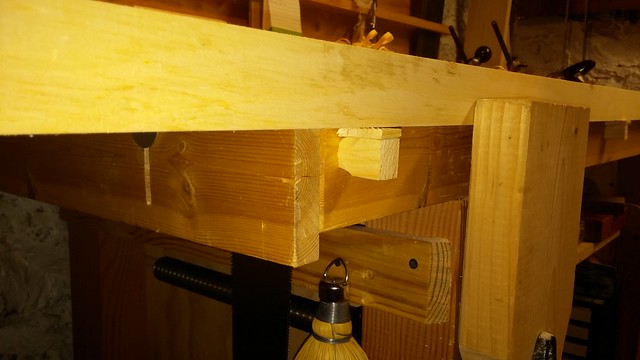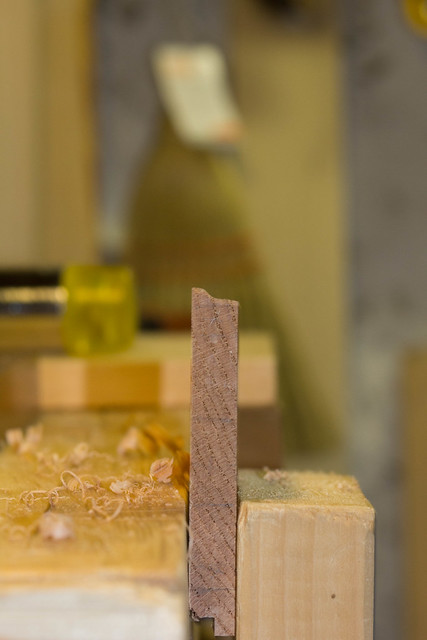So I've been thinking about it, and I've decided to make a pair of devices to solve the problem. One, which I'll build later, is a "milkman's bench", from the plans in Popular Woodworking a while ago (June 2013, according to the internet). The first project is a small tool chest.
I'm planning to base it on a Japanese toolbox design, with a few modifications. There's a sample of the design here. I've seen a few variations, and my intent is to borrow a few of them. While the standard design has no dividers, I'm considering adding one, to separate saws from everything else. I'm also planning to set up the top so that I can set it on a bench or tabletop and use it as a bench hook and shooting board; that will probably necessitate replacing it periodically, but that's OK. The idea is quick and inexpensive. To be honest, I expect nails to cost more than everything else put together, since I'd like to do square nails, and clench them in some spots.
For tools, I'm going to try to figure out a really minimal set. Here's what I'm thinking at the moment.
- Saws. My Shark Ryoba should handle the majority of chores, being cross or rip cuts in more or less any wood. I'm also planning on a coping saw, since curves aren't really practical with the Ryoba. I'm torn on the Veritas Carcase Saw; it's tremendously useful, but I'm not convinced it's worth the weight.
- Chisels. I'm planning on 1/4, 1/2, and 1" chisels. They should cover just about any need I have. These will need a tool roll, but that's OK.
- A hammer and a mallet. My mallet at the moment is a cheap Harbor Freight panel beating mallet, and it works great. The hammer will drive nails, and the mallet will adjust planes, drive chisels, and knock things together when I'm doing glueups.
- Brace and bits. I'm a little bit torn on this. They add a LOT of weight, but they're really the best option for making holes bigger than about 1/4". Probably they'll go in.
- Hand drill and bits. This might end up being my full roll of bits, but more likely I'll buy a small box of common bits, and call it good.
- Gimlets. They weigh practically nothing, and they're the best tool I've ever found for starting screws. Done.
- Planes. I think I'll have a #5, #3, and the wooden shoulder plane in my regular kit. That covers stock removal, jointing, smoothing, and rabbets, which is most of what I'll need. I'll likely also toss a Veritas medium router plane in, because there are some things you just can't easily do otherwise.
- My shop apron. The pockets of the shop apron hold: a tape measure, a six inch combination square, a marking knife, a mechanical pencil, a folding 12 rule, and a very small six inch rule, which is great for checking mortise depths and things like that.
- Odds and ends. The finest plate from my DMT set, a block of paraffin wax, a strop, scrapers, and stuff like that. Probably a 16" rule, but maybe not. Likely a bottle each of hide glue and Titebond 3. At least one marking gauge. Maybe a spokeshave, but maybe not. Certainly a four-way rasp/file.
The real question in my mind is how much this is all going to weigh. I'll probably drop it all in a bag or a bucket before starting to build, in case I wind up needing to slim it down further. I could probably replace the #3 plane with a coffin plane, which would leave me the value but drop the weight some.
So what do I expect to be able to do with this? Basically anything. The ryoba and chisels mean I can cut dovetails. Adding the carcase saw would mean I can suddenly cut dados, open or stopped, and grooves, and clean them with the router plane, which can also do things like hinge or lock mortises The shoulder plane can cut rabbets. Between the brace, hand drill, and gimlets, I can put a hole of any size in pretty much any wood. With the coping saw, chisels, and a rasp I should be able to make curves of almost any radius, either inside or outside.
Some things will be difficult. I wouldn't want to make a raised panel with this set, or cut grooves in anything very large. I'm considering ordering the Mujingfang plow plane: If it's decent, I might keep it for this chest, as a light-weight option. If I could manage to replace all of the planes with wood, that would lighten it up considerably, leaving the brace as the single heaviest item.
So what do I expect to be able to do with this? Basically anything. The ryoba and chisels mean I can cut dovetails. Adding the carcase saw would mean I can suddenly cut dados, open or stopped, and grooves, and clean them with the router plane, which can also do things like hinge or lock mortises The shoulder plane can cut rabbets. Between the brace, hand drill, and gimlets, I can put a hole of any size in pretty much any wood. With the coping saw, chisels, and a rasp I should be able to make curves of almost any radius, either inside or outside.
Some things will be difficult. I wouldn't want to make a raised panel with this set, or cut grooves in anything very large. I'm considering ordering the Mujingfang plow plane: If it's decent, I might keep it for this chest, as a light-weight option. If I could manage to replace all of the planes with wood, that would lighten it up considerably, leaving the brace as the single heaviest item.
In any case, it should prove interesting!












